Anton Mesmer: History of Mesmerism & the Beginnings of Hypnosis
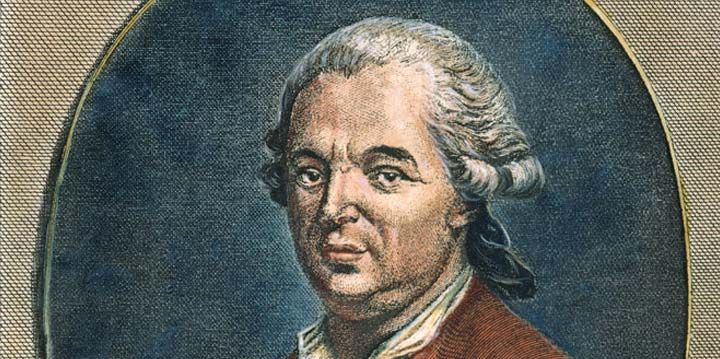
Anton Mesmer & The History of Hypnosis
It is often assumed that hypnosis finds its roots in Mesmerism. This is only partially true because what has become known as modern hypnosis is not Mesmerism, modern hypnosis and traditional Mesmerism are as different as what day is from night. Mesmerism was the name given to a healing practice that was discovered and perfected in the 18th century by Franz Anton Mesmer, often referred to as Anton Mesmer; and occasionally, albeit incorrectly, as Friedrich.
Franz Anton Mesmer was a German Doctor who used energetic manipulations of what he called an "Etherial Fluid", to produce a cathartic reaction in his often female patients. However Mesmer's, "Mesmerism," it's methodologies and it's practical applications bear little resemblance to the induction methods that are used to intentionally induce the trance state of Hypnosis. During the process of Mesmerism energetic manipulations are applied by stroking the energy field of the patient (passes) and very few, or no words at all, are spoken during the induction or application of the Mesmeric trance. In contrast to Mesmerism, modern hypnosis ignores any energetic transference and hypnosis is induced primarily by the use of words.
Since the early 1950s traditional hypnosis has been somewhat distilled into various hybrids to the point where it is now more often offered as what is known as Ericksonian Hypnosis, named after the American Psychiatrist Milton Erickson. Erickson was a medical doctor, a Psychiatrist, and a naturally gifted behavioral expert. Most modern practitioners of Ericksonian Hypnosis have nowhere near his scientific or medical education, and none have his natural talents either. Another often pseudo hypnotic technique is NLP or Neuro Linguistic Programming. NLP is not true hypnosis in any sense of the word and all studies to date have shown it has no more benefit or lasting effects than attending a good motivational seminar.
Hypnosis in the true sense of the word is Traditional Hypnosis, wherein deep states of trance are induced rather quickly and then the subconscious mind is given direct positive suggestion to change a behaviour, alter the subjects perception, and change or break a habit. The use of traditional hypnosis in the therapeutic arena is rare these days, and practitioners of genuine Mesmerism are even rarer. The Australian Academy of Hypnosis is one of the few Hypnosis Training Institutions that teaches both of the methods.
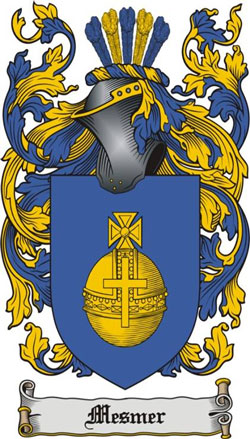
The Mesmer Crest (coat of arms)
In contrast to Ericksonian hypnosis and NLP, traditional hypnosis is supported by more than 3000 high quality research papers which attest to its valid existence and lasting benefits that can be gained for all manner of addictions, habits, and illnesses. Rick Collingwood; Mind Motivations; & The Australian Academy of Hypnosis use and teach Mesmerism and traditional fundamental hypnosis.
Modern hypnotism began with Franz Anton Mesmer which is why it is sometimes referred to as Mesmerism. Following in Mesmer's footsteps were the British Doctor James Braid who conceived the word hypnotism, and the Scottish Surgeon James Esdaile who performed over 1700 surgical operations using non verbal Mesmerism as an anesthetic. As Esdaile wrote in one of his early books "Mesmerism is not purely the use of the imagination, because even the greatest imagination in the world cannot ward off the pain felt and suffered by one as the saw cuts through the muscle and bone during the removal of a diseased arm or leg."
In 2009 whilst conducting seminars and media interviews in London, Rick Collingwood visited the small town of Meersburg in Germany to pay respects and place flowers on the grave at the monument erected to the memory of Anton Mesmer, the 18th century Doctor who bought hypnosis to the world. At the bottom of this article are a number of photos.
Franz Anton Mesmer
The saga of Franz Anton Mesmer was exceedingly dramatic and extended far beyond his death. It resulted in a veritable age of Mesmerism, the vitality of which took on international interest and fascination that endured for about 140 years.
Franz Anton Mesmer (1734-1815) was born on the 23rd of May 1733 at the village of Iznang near Switzerland, on the German side of Bodensee (Lake Constance). His father was a forester employed by the archbishop of Constance; his mother was the daughter of a locksmith. It was a large Catholic family and not particularly prosperous, Franz Anton was the third of nine children. By all accounts, he was of copious intelligence and a somewhat high-minded individual, whose thinking was completely in keeping with his times.
Indeed such was the strength of Mesmerism that it came to constitute one of the first international movements of any kind. And its international vivacity was such that the anti-energetic sentiments in the mainstream modern sciences did not succeed in deconstructing it until about 1920. Even then, Mesmerism left three long shadows of itself: the first in the guise of hypnotism; the second in the guise of psychical research; the third in the guise of the energetic mysteries.
Modern historians seldom consider him as a person within his times but assess him according to modern standards as they later developed. And by those later standards, Mesmer's activities consisted of one strange folly after another.
After preliminary studies in a local monastic school in Constance, Mesmer commenced the study of philosophy at the Jesuit University of Dillingen, Bavaria, changing in 1752 to theology, presumably as a scholarship student preparing for the priesthood. He continued his studies from 1753 at the University of Ingolstadt, where he soon abandoned theology. It is not known when or from what learning institution he obtained his doctorate in philosophy. A year later he began practice as a member of the faculty of medicine in what was one of Europe's most advanced medical centers; for the Vienna school was then in its prime, owing to the patronage of Maria Theresa and the leadership of Gerhard van Swieten and Jan Ingenhousz.
By the time he began to propound his theory of animal magnetism, or mesmerism, Anton Mesmer had risen through the educational systems of Bavaria and Austria and had advanced to a position of some social prominence in Viennese society partly through association of his marriage two years after his medical graduation to a wealthy Viennese widow of an army Lieutenant Colonel, Maria Anna von Posch, on January 16, 1768. By all accounts, the wedding was a splendid affair conducted in the fourteenth century St Stephen's Cathedral by cardinal Migazzi, the Archbishop of Vienna. However the marriage was not a happy one, Mesmer found Maria stupid, dull, and somewhat crass. Presumably this downside was more than offset by her more positive qualities; she gave him money and respectability, and she already had a teenage son, Franz, and Mesmer had never had any children of his own.
Maria's father must have had reservations about her choice of a spouse, especially one ten years her junior, and although he allowed Mesmer access to her fortune to support his life style, he excluded him from any inheritance of her estate, but bought them a Mansion at 261 Landstrasse, in the most prosperous district of Vienna. The mansion was noted for its gardens, groves, walks and fountains and soon Mesmer also added to the property by building laboratories and a small outdoor theater. Here he often practiced and cultivated his own performances on the cello, clavichord and the glass harmonica. (There is nothing in the history books that alludes to how Mesmer's marriage ended, or what became of Maria Anna von Posch, although Mesmer did leave Vienna for Paris in 1778 ten years after he had married Maria).
While he was a medical student at the University of Vienna, Mesmer was impressed by the writings of the astronomer Richard Mead and the Renaissance mystic physician Paracelsus (Theophrastus Philippus Aureolus Bombastus von Hohenheim, 1493-1541) and attempted to rationalize a belief in astrological influences on human health as the result of planetary forces through a subtle, invisible fluid. It was a friend of his, the astronomer Maximilian Hehl (1720-1792), a court astronomer and Jesuit priest, who used magnets in the treatment of disease, and influenced Mesmer to conduct his first attempts at healing with a steel magnet.
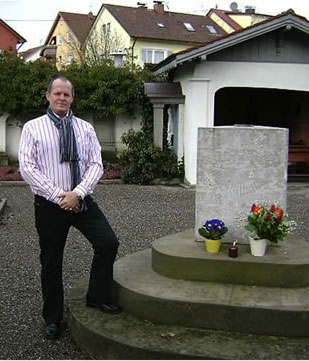
Rick Collingwood standing next to Mesmer's burial monument in Meersburg, Germany
Mesmer became convinced that everybody possessed a magnetic force or fluid which constantly connects all living things and all living human beings at any distance. The immediate source of Mesmer's fluid was Richard Mead's (1673-1754) De imperio solis ac lunae in corpora humana et morbis inde oriundis (London, 1704), a work upon which Mesmer's doctoral thesis drew heavily. Mead had argued that gravity produced tides in the atmosphere as well as in water and that the planets could therefore affect the fluidal balance of the human body. Mesmer was educated in Vienna where he took a degree in medicine.
The thesis that Mesmer submitted for his Doctorate was titled "Dissertatio physicomedice de planetarum influxu"(the influence of planets on the human body). In modern contexts, this document is mistakenly condemned as Mesmer's "astrological thesis". But Mesmer was known for his dislike of astrologers and thought of them as nothing more than Charlatans. His thesis examined Astrological magnetic energetic influences that were thought to be universal in nature.
Mesmer observed that the action of the magnetic influences "consists of alternating effects which may be considered as fluxes" of sympathetic systems. The effects manifest in the human body with properties analogous to the magnet. There are poles, diverse and opposed, which can be communicated, changed, destroyed and reinforced; the phenomena of inclination is also observable. In later summarizing his thesis, he indicated "The property of the animal body which renders it susceptible to the magnetic influence of the celestial bodies, and to the reciprocal action of the environmental ones, I felt prompted to name, from analogy to the magnet, animal magnetism."
It should be considered that the contexts Mesmer was using referred not to Astrology but to Astronomy and not to "Animal" magnetism, but to ANIMATING magnetism-and that, during his times, this usage was understood and accepted.
Medical Uses of Magnetic Plates
Mesmer was one of the many physicians who were exploring cures and healings via magnets. Mesmer apparently innovated, designed, and constructed his own version of magnetic plates. By applying his magnetized plates to patient's limbs, he affected his first cures in about 1773. Unfortunately, what these plates consisted of has been lost. But probably analogous to them are various magnetic plates designed in Japan during the 1980s, which also produce cures. Further, the application of weak electromagnetic currents to bone fractures and ulcerous infections has been scientifically and medically confirmed as speeding up healings and cures.
Mesmer came to special public attention because of a bitter, and quite public, controversy involving the invention of his plates, as the priority of this invention was claimed by his earlier friend, the Jesuit priest having the curious name of Maximillian Hehl, a professor of astronomy/astrology at the University of Vienna. Mesmer won the claim, but was quickly involved in another controversy involving the cure of a blind girl.
At some point between 1770 and 1775, Mesmer was among the many physicians and intellectuals who witnessed a number of cures affected by the strokings of J.J. (Johann) Gassner without the use of magnets. Because of this, Mesmer correctly conceptualized that the human body possessed a magnetic "field," and that such fields could affect each other. Mesmer thereafter disposed of his magnets, and for a fresh start he also abandoned Vienna.
In February 1778 he traveled to Paris, the city of lights and set up what soon became a very lucrative clinic in the Palace Vendôme and another in the nearby village of Créteil. He then began an elaborate campaign to win recognition of his discovery from France's leading scientific bodies. Helped by some influential converts and an ever increasing throng of patients' who testified that they had been cured of everything from paralysis to what the French then called "vapeurs" (hot flushes accompanied by nervous fits and hysterical fainting). In Paris Mesmer seized the public's imagination, and quickly developed novel techniques and equipment to effect cures. The exact nature and materials of the new equipment (Baquet's) have been lost to posterity. But not their impact, resulting scandals, and the extraordinary controversies that came to surface around the name Mesmer.
Mesmer's Magnetic Vats
Once installed in Paris, Mesmer established himself in the Viennese Masonic scene and the occult scene as well; his friends were numerous and included the composer Mozart. He is known to have joined the order of the Gold and Rosy Cross, one of the most prominent esoteric orders of the 18th century. Within the order Mesmer gave lectures and educated some 300 pupils, who were soon active in 40 societies all over France. He achieved a tremendous success with the public, and with the subscription connected to his name by his pupils, he became a rich man and was at the height of his influence. In 1785 one of his pupils, in a breach of confidence, published the doctrines of Mesmer Aphorismes des M. Mesmer, which were supposed to be kept a secret.
Mesmer designed several versions of a large circular vat (in French, BAQUET), that were filled with "certain substances" that apparently consisted of mixtures of various metals and shards of glass. Whatever the substances consisted of, they served to "collect animating magnetism" and transfer it and its sympathetic qualities to the sympathetic systems of the patients. The theory was that the "certain substances" collected and amplified the magnetic forces, and then via hand-held connectors; the forces were transferred to and re-saturated the sympathetic systems inherent in the bodies of the patients.
The methods utilised to affect the transfer tend to boggle the imagination. The patients sat around the vats in communal groups, each holding a metal or glass rod, or a mere copper wire or string of thread, the other end of which was pushed into the substances in the vats. Mesmer erected several circular vats, each about a foot high, and experimented with a number of hand-held "connectors" that served as conduits for the animating and re-animating magnetisms.
There is no doubt that some cures were attained for ailments strictly physical in their cause, but even more cures were obtained regarding illness mental (psychosomatic) in origin. Even Mesmer himself indicated that his "techniques" better dealt with what we today would refer to as conditions psychosomatic in origin. Indeed as a physician, Mesmer usually, and correctly, first sent physically ill patients to other doctors, and otherwise accepted them only if physical remedies were of no effect.
The Energetic Phenomena of the Vats
Although the exact material constituents of the circular communal vats have been lost, the nature of the energetic phenomena experienced by the "patients" has not been. As described (usually too briefly) in most sources, these phenomena consisted of "violent convulsions, cries, uncontrollable laughter, and various physical symptoms," followed by "lethargy" after which the cures became apparent.
WHAT was cured, and WHY it was, remains an historical mystery, confounded by expressions of awe, shock, and professional hysteria. On the face of the brief descriptions of the phenomena, it is difficult to know exactly what was actually meant by "violent convulsions." Later scientific criteria established "convulsions" as consisting of quite serious and very painful involuntary contractions of the muscles during which the nervous system goes haywire, sometimes resulting in a coma.
It is also difficult to understand what is meant by "various physical symptoms," or even what was meant by "cries" and "laughter." However, the sum of all of these phenomena quite clearly falls into the category of catharsis of the ecstatic or ecstasy type. And obvious clues regarding this can be comprehended not by studying the phenomena, but by examining WHO attended upon the vats. Many had no visible ills to cure. If this particular issue is examined, it will be seen that they came just for the thrill of experiencing the animating, magnetic energies.
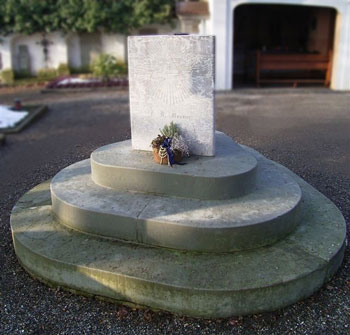
A closeup shot of Mesmer's burial monument in Meersburg, Germany
The Social Background Regarding the Vats
Mesmer's reputation had preceded him to Paris, and once installed there he acquired numerous supporters. Principal among these at first was Dr Charles d'Eslon, medical adviser to the Count D'Artois, and brother of King Louis XV1. This was high patronage indeed. d'Eslon, was eventually struck off the register for his pains. In time, however, their ways were to part when d'Eslon practising independently annoyed Mesmer.
In September of 1780, d'Eslon asked the Faculty of Medicine to confirm Mesmer's ideas and techniques, a request that was rejected. None the less, public enthusiasm and high patronage support had grown to impressive heights. Then in March 1781, on behalf of the King, the powerful Minister M de Maurepas, offered Mesmer 20,000 livres (a significant amount), and a further annuity of 10,000 if he established a school and agreed to divulge the "secret" of his treatments. Mesmer at first refused, but later accepted a subscription of 340,000 livres for lectures to pupils. (Livre could refer to a weight measurement at the time or to the value of 1 Livre equals 1 Franc) With this financial arrangement, Mesmer increased his vat facilities, and surrounded them with rather impressive environments. These consisted of large rooms noted for the opulence of their furnishings, with enormous reflecting mirrors, the whole room being rather dimly lit.
Mesmer and his vats were mobbed with applicants, among them vast numbers of the aristocracy and royalty. Many memoirs of various members of the aristocracy establish that the mob included even Queen Marie Antoinette and the whole of her court. Well acquainted with the family, he also saw a great deal of the Mozart's. The first production of a Mozart opera, the Bastien and Bastienne, took place in Mesmer's garden at his Viennese mansion, and Wolfgang Amadeus Mozart (1756-1791) later made room for mesmerism in a scene in Cosi fan tutte
Spontaneous Sexual Orgasm at the Vats
It is from memoirs, often not consulted by biographers of Mesmer, that a complete picture of the "convulsive" catharsis is revealed. There is no doubt at all that those holding the connectors often experienced an aspect of ecstatic catharsis known from ancient times, a kind of involuntary auto-orgasm in females and auto-ejaculatory release in males. Hence the connection among the "convulsions," "cries," "laughter" and subsequent "lethargy" tend to fall into place, since these taken altogether are recognizable and familiar constituents of sexual orgasm. And indeed if the convulsions had been painful or unpleasant, it is quite unlikely that applications to sit at the vats would have been any more numerous than the cases of those willing to try anything and everything to ameliorate their ills.
Mesmeric Trances
Also known from ancient times, ecstatic catharsis engendered dramatic and empowering shifts in levels" of consciousness of the kind we would today refer to as heightened or "altered states" and during which many kinds of so-called "paranormal" trance phenomena were experienced. Such phenomena also came to light within many of Mesmer's vat participants. But a perpetual confusion has settled in regarding this matter, in that mesmerist trance phenomena have been historically confused with hypnosis. Hypnotism can easily be confused as an extension of Mesmerist trance, since it too is a type of altered state. But in actual historical fact, hypnotism as such was not identified until about 1842 by the English surgeon, James Braid (1795-1860). Braid first termed the phenomena as "Neuro-hypnotism," a phenomenon that also occasionally aroused involuntary sexualizing energies. Types of hypnotism however had earlier been identified in ancient Persia and India, with probably even more ancient antecedents in Egypt. In any event, Mesmer's stay in Paris was cut short, leaving Mesmerist trance phenomena to be investigated later by his followers.
Mesmer's Expulsion from France
Although a great deal has been written about Mesmer's expulsion from France, it remains unclear as to why and how the expulsion was instigated. The official story holds that in 1784, the "French government" charged the Faculty of Medicine, the Royal Society of Medicine, and the Academy of Sciences, to examine "animal magnetism."
Nine Commissioners were convened under the presidency of Benjamin Franklin, then in Paris, and included the astronomer, Jean Sylvain Bailly and the chemist J.K. Lavoisier, both esteemed scientists of the time who both met their deaths during the French Revolution from the invention of one of the other commissioners whose name was Guillotine. The commissioners were restricted to the activity of attempting to establish evidence of a new physical force that was claimed as the agent of the cures. But it is clear that the actual target was Mesmer himself, and that the actual purpose was to get rid of him.
Having fallen out with his past supporter Dr d'Eslon because of d'Elsons insistence at using all manner of strange contraptions and excuses to support the existence of magnetism, the commission was conducted at d'Eslon's estate. The report of the commission concluded that far from being able to cure disease, Mesmer's ethereal fluid did not exist. They termed him a deceiver and ascribed Mesmer's "healings" to the fantasy of the individual, and physicians using his method were threatened with the loss of their practice. The only member of the commission to speak for Mesmer was the famous botanist Adran Laurent de Jussieu.
Although an independent report was conducted the commission also produced two other reports, but between them the consensus among the Commissioners is quite garbled. Franklin, for example, recommended further examination of the issue. But King Louis XV1, not known for much in the way, of certitude, was somehow stampeded to order Mesmer's expulsion from France, which was effected very quickly.
The French Academy of Sciences and the Royal Society of Medicine had initially expressed cautious interest in Mesmerism, and then decided that he was a quack and refused to have anything further to do with him. As Mesmer's clientele and reputation grew, their ire against him escalated into open attacks in magazine articles and the pamphlet press. Mesmer, his followers, and many people he had cured responded by publishing articles and pamphlets of their own, denouncing the medical establishment of the time as a collection of jealous incompetents fighting to maintain their monopoly over medicine at the expense of public health. The resulting frenzy kept the media busy and the public entertained until the beginning of the French Revolution nine years later brought other matters to the forefront of public attention.
Mesmer was not actually forced to leave Paris, and he remained there along with the popularity of the Baqutte's for eight months after the Commissions findings were handed down. Another fact often overlooked or not realized is that none of findings of any of the Commissions, of which there were two official and a private almost secret third, denied the obvious and often swift cures that often resulted from Mesmerism. The reports did not discredit the effectiveness of Mesmerism. The discredited the existence of Mesmers theory of an "Etherial Fluid", which would today be described as the human energy field. Regardless of the lack of understanding of the mechanisms of Mesmerism, nobody has ever decried it's effectiveness or denied its results.
After the findings of the commission Mesmer left Paris for London, and proceeded from there to Austria, Italy, Switzerland, and Germany, continually trying to win the universal acclaim he believed he deserved. Eventually he returned to a village near his birthplace, Meersburg, in Germany, where he lived a quiet unobtrusive life until he died on the 5th of March 1815. How it was that Mesmer, a veritable supernova, thereafter consented to a life bordering on obscurity remains something of a mystery.
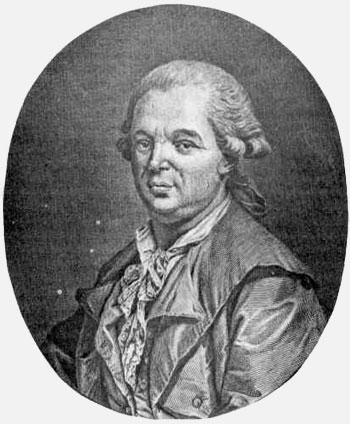
A very old illustration of what Franz Anton Mesmer looked like
Despite the negative findings of the commission and all his jealous colleagues, it was however the French revolution that ruined Mesmer's practice. During the revolution he lost his entire fortune and fled initially to England. Then in 1798 he returned to France attempting to regain his fortune. In 1802 he moved to Versaille and made a settlement with the French government, which granted him a small pension. In 1803 he left France for good, first living in Frauenfeld in Thurgau, and then retired to Meersburg, where he practiced medicine from 1807. Here he apparently led a quiet and contented life, doing a little medicine, playing his glass harmonica, and remaining detached from the outside world. In the meantime, animal magnetism was practiced as a therapy all over Germany. In 1812 professor Karl Christian Wolfart (1778-1832) from Berlin visited Mesmer at the request of the Prussian government in order to be educated in his methods. At the same time Johann Ferdinand Koreff (1783-1851) was already in Paris on a similar mission. Wolfart remained Mesmer's staunchest supporter, and instigated the printing of Mesmer's main work, Mesmerismus, oder System der Wechselwirkungen, in Berlin in 1814. In the summer of 1813 Mesmer moved to Constance, one year later to the village of Riedetsweiler near Meersburg, soon moving on to Meersburg, where he died on March 5th, 1815. His memorial at the beautiful cemetery on the hill above the village of Meersburg was designed by Wolfart, and bears large carved Masonic symbols on each of its three sides. Excepting for the theft of the sundial sunk into the top face in 2009; Karl Wolfarts monument at Mesmer's final resting place remains in a very well preserved condition to this day.
Mesmerism became confused with being hypnosis probably because in 1814 the Abbe Faria suggested that the phenomena described by Mesmer were not due to animal magnetism, but was actually due to suggestions. However, there can be found no mention of verbal suggestions being used at the Vats, and in his early writings Mesmer often wrote that the trance state was not necessary for the beneficial effects of magnetism, and with the popularity of Mesmer now being so well established Faria's theories and his hypothesis was mostly ignored and very soon forgotten.
Although through envy and misunderstanding many of his learned contemporaries regarded Mesmer's practice of magnetism as quackery, even now in the 21st century his theory of animal magnetism is still mistakenly credited as having laid the foundations of modern hypnosis and suggestive therapy.
*Having moved to a cottage in Meersburg and then to from his summer chalet at Riedetsweiler, a village nearby. Mesmer died of a stroke on the German side of lake Constance in which he must have swum when a boy. It is from his friend Justinus Kerner, thanks to whose book, published in Frankfurt on the Main in 1856 that we know so much about Mesmer's last years.
Justinus tells us that Mesmer died smiling, a strange thing indeed. Strange, too, is the tale of the magnetizable canary which would fly from its cage, always open, and perch on Mesmer's head to sing him awake every morning; perch on the sugar basin while he ate his breakfast and anticipate his needs by pecking extra lumps into his coffee cup.
The end of the tale, as Kerner relates it, runs "One evening Mesmer gave the canary bird an extra affection, the next morning Mesmer lay in repose as though he were still alive, but never again did the canary bird fly on to his head to wake him. It ate no more and sang no more and soon it was found dead in its cage".
Far stranger, however, to me at any rate, is the impression I have gathered that when it came to clinical treatment, the discoverer of animal magnetism pinned his whole faith to the therapeutic value of the Mesmeric "crises", setting little or no value on the mesmeric "trance". *Taken from the Book: Mesmerism, by Doctor Mesmer (1779) and translated into English by Gilbert Frankau (1948)
Mesmer himself gave much more significance to magnetism and the transference of the Ethereal Fluid than he did to the trance state, confirming that Mesmer considered himself a Magnetist and not a Hypnotist.
Although it appears that Mesmer moved far and often during his last years, Frauenfeld, Constance, and Meersburg are less than twenty kilometers apart. Lake Constance (Konstance) is bordered by the three countries of Switzerland, Austria, and Germany. It is probably because of the close proximity of the three countries surrounding the lake that some poorly researched historians confuse Mesmer as being Swiss, Austrian, or German. He was born at Iznang which is in Germany.
Nowadays a one hour train journey from Zurich airport passes through Frauenfeld to Constance, and modern ferries operate 24 hours a day carrying cars and passengers on a 20 minute crossing of Lake Constance to Meersburg.

















Post new comment